Live from Tour de France: NBC Sports Network tells story of Stage 7 to Nuits-Saint-Georges
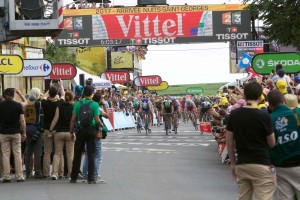
Marcel Kittel pips Edvald Boasson Hagen on the line to take Stage 7 of the 2017 Tour de France in Nuits-Saint-Georges. Photo: Tom Woods
A sensational photo finish saw Marcel Kittel from Quick-Step Floors snatch victory over Dimension Data’s Edvald Boasson Hagen thanks to Kittel’s seemingly despairing last-gasp bike throw over the line on Stage 7 of the Tour de France into Nuits-Saint-George in the beautiful burgundy wine-growing region. For the hard-working NBC Sports Network production team this amazing 6mm-separation photo finish provided another dramatic story line for its unilateral coverage of the world’s greatest bike race.
SVG Europe spent the Stage 7 day in the TV compound in the company of NBCSN, production and facilities company Woods Communications and OB facilities provider NEP Group, in order to gain an understanding of how one rights holder goes on air each day for what many in the business describe as ‘the toughest event in sports television’.
Each day of the Tour, NBCSN takes the world feed from host broadcaster France Televisions and uses isolated cameras plus produced elements to make a unique TV show. For major mountain stages NBCSN goes live for the whole day; for flat stages where there is not so much action early on, it will pick up the action perhaps 90 minutes into the day’s race.
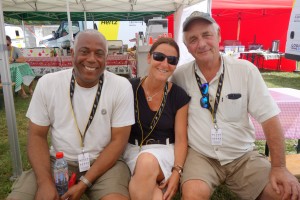
Lunchtime on Tour: (L/R) NBCSN Director Kelly Atkinson; Woods Communications Director of Production Operations Anne Rapoport; and NBCSN Coordinating Producer David Michaels
In addition to the play by play race commentary team of Phil Liggett and Paul Sherwen, NBCSN also has a studio commentary team comprising Host Paul Burmeister with Analysts Bob Roll and Christian Vandevelde, from a dedicated purpose-built three-camera two-sided studio truck provided by Woods Communications in partnership with Dutch company Event Rent. The on-air commentary team also includes Finish-Line Analyst Jens Voigt and moto-mounted Commentator-Analyst Steve Porino.
In the production truck, Coordinating Producer David Michaels, Director Kelly Atkinson and Live Producer Joel Felicio and their team blend race commentary and studio inserts with pre-race interviews recorded on the start line from NBC’s camera team and uplink, a dedicated camera at the finish line and its own graphics with data supplied by SMT to produce an ‘American-style’ live sports version of the Stage.
Once the race is run, the studio team takes over for a one-hour post-race show close to the finish line, bringing in racing team directors to provide perspective on that day’s events. Digital platform NBC Sports Gold also streams the Stage in its entirety each day, from the France Televisions world feed.
The production truck is NEP Belgium’s Unit 15, housing Sony MVS7000 switcher, Lawo VSM control, Lawo MC2 66 audio console, Belden GVG NVision router, ChyronHego graphics, Riedel Artist intercom and Axon glue. The cameras are a mix of GVG and Sony, with a Vislink 4away ENG HF system, Panasonic Hothead beauty camera and Marshall CV500 mini ‘spy’ camera. Driving the production are EVS XT3s, Sony XDCAM and HDCAM VTRs, alongside three Avid Media Composer edit stations (in a separate NEP truck) and three NEXIS servers with Avid ISIS5000 storage, all working with EVS IP Director.
Live Producer Joel Felicio told SVG Europe, “most days we come on air at 1:30, and some days we’re on as early as 12 noon. We take the world feed and put it up on our digital platform – otherwise it depends on the stage.
“We’re big on statistics, so I’m constantly putting in statistics with full-page graphics. We use the Chyron to type up pages like how many wins Marcel Kittel has, for example. SMT does speeds for us, how fast the riders are going. They do anything data-driven, like who’s in the lead group, rider X, Y, and Z, and the gaps between groups,” said Felicio.
“We pre-produce a lot of elements in the Avid. We have a lot of interviews that we chop up and put in there. We’ve a camera at the start line to gather ENG stuff and we feed it from there and play it into the show – our own camera and uplink, sending us rider-interview material every morning.
“Steve Porino is on a motorcycle, so like today I could get on the PL with Steve and say, ‘hey, Nacer
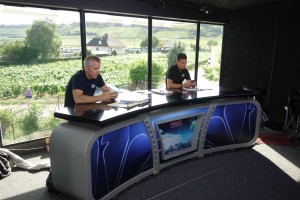
Off-air: NBCSN Analyst Christian Vandevelde and Host Paul Burmeister in studio, in front of glass panels treated with a Rosco polariser system to darken the bright sunlit background outside
Bouhanni has just had a bike change, we need to know why’. Steve talked to his team director and found out that Bouhanni’s battery died. Steve is out there telling us about the team strategies, what the weather is like and so on. Then we have Jens Voigt at the finish, and since he just retired a couple of years he can give us ‘inside the peloton’ perspectives. I can ask him ‘Jens do you think the breakaway is going to make it today – you’ve been in that situation, tell us about it’.
“A lot of people take [our coverage] for granted, as they wake up and it’s just on every day,” said Felicio. “I can work on a regular event back home and we’ll have problems setting up the day before. Here, our trucks are moving every day! Each morning when we come in at eight o’clock we open the doors and everything’s on and everything works.
“These guys tear it down each evening and then travel through the night over mountains. They serve it up on a plate for us, having cooked it up all night, and all we’ve got to do is eat it! And if they didn’t, then we would be in trouble, playing catch-up all day long. They do a stellar job. And they do it with a smile too,” he said.
“I have been in this business all my life, and I could look at anything I’ve done — any Olympics, any large event – and there is absolutely nothing like this,” said Coordinating Producer David Michaels. “It’s the craziest. Look around the compound here: in probably 16 hours there will be no sign of any of this. Everything moves: every cable, every bit of fibre needs to be reassigned and plugged in every day. It’s like loading a big ferry boat.
“One of our priorities is to ensure that our studio has a nice backdrop every day. Kelly is involved on a daily basis on where to put the truck and where to orient it, and how to reconcile that with how close it is to the finish line,” said Michaels.
“Today you can see how far we are from the finish line, so this is a challenge for our guys making those cable runs,” added Director Kelly Atkinson.
“Sometimes we’re on the air for an hour before we ever go to the host feed,” said Michaels. “Sometimes we may be telling a story of a particular rider and we have isos of some of the motos and helicopters so Kelly can follow the story and we can do more of our own thing. We can box up our interviews from each morning and it’s very much an American-flavoured show.”
“For the Cavendish and Sagan crash,” added Atkinson, “we stayed on the air in our post-game show until we knew what was going on. We had reaction from Cavendish, we had reaction from Sagan, we had both team managers, and we had the UCI announcement” [that Sagan had been disqualified].
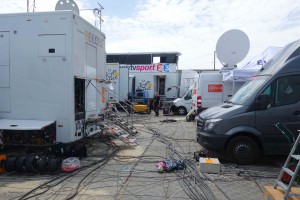
Cables everywhere: View inside the Nuits-Saint-George TV compound, where trucks spend roughly 18 hours before driving to next Stage finish
“There’s nothing else like the Tour de France,” said Tom Woods. “Our partnership with NEP has been really good. To be honest we were a little apprehensive, with this huge company coming in, that it would be just one more job for them: but they have been terrific. Everyone has to work together: David and Kelly, Joel and the entire NBC team, Brian Clark from NEP Major Projects, the catering guys – everyone is in it together because there’s no other way to get it done. That’s what’s unique about the Tour, that integration between all the players, the host broadcaster, the clients, event organisers – and the guys pulling cables at six o’clock in the morning.”
Production, technology and logistics in a permeable environment
“We act as a production and logistics company and we also provide technical supervision and integration,” said Woods. “It’s a partnership with all of the players, most of all with NBC. We also have a very productive and efficient relationship with NEP.
“It’s a year long process for Woods to be able to provide those services to NBC. Essentially it starts in the middle of this Tour: we’re also preparing for next year’s Tour. The official announcement of the route for next year is in October, when our Director of Production Operations Anne Rapoport and Accommodations Manager Audrey Sassu have to find 60 hotel rooms that change on an almost daily basis, for us and all of our sub-contractors.
“You’re arriving into a little town with no hotels, and you’ve got to feed, house and get those people from one place from one to another in reasonable order – that becomes a big part of it,” said Woods. “It does have a military operation feel as it is heavy on logistics and heavy on communication between all these different entities. You have the NBC group, the NEP group, the Woods people, the folks in catering, the transportation captain: it’s really our job to bring all of those people together, every day, to make sure that operation functions as a whole,” he said.
“There’s so much coordination between everything on this event that you can’t isolate one area; it all overlaps,” added Rapoport. “Another big component is the liaison with the organiser ASO and host broadcaster France Televisions; that’s big because the daily constraints are huge depending on where the stage finish occurs.
“If we have a mountain-top finish where the compound is going to be down the mountain we jump in
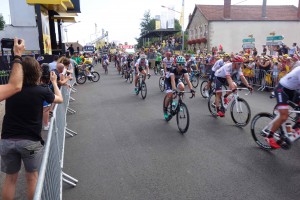
End of race: Peloton cruises to a halt after the finish line, while maillot jaune Chris Froome (on left) from Team Sky turns directly into the podium enclosure
to work with ASO as to how we’re going to get all the iso feeds we need and our uplink at the top so we can still put our NBC analyst Jens Voight on the finish-line. On another stage we need to drive our vehicles to the top and they have a shuttle system organised for all the media, and we don’t want that and so we start negotiating. It’s very hard to separate all the things we do here – and I think that’s particular to this unique event,” said Rapoport.
“It’s a very permeable environment,” said Woods. “There’s no other sport where you can reach out and touch the players. You can pour water on the cyclists, or give them a push up the hill. And that’s all part of the Tour. There’s no other event, anywhere in the world, where in the better part of four weeks it touches the entire country – all of the afficianados and all of the people who love cycling. Yesterday’s stage was 216 kilometres long. What other playing field is 216 kilometres long?” asked Woods.
“We’ve got to give kudos to Anne and Tom and the team,” said Michaels. “If you think about this: everybody needs a hotel room, and it’s got to be relatively close to where we’re working. The live show is over each day at six o’clock local time, and then we need to do some elements for primetime and then hopefully get out by seven. Meanwhile everyone is trying to wrap up and all the barricades are coming down and spectators are moving. Then we get in a car and have to drive a couple of hours to the next stage, maybe eating a sandwich in a gas station. And there’s a separate start-line operation, that does all the interviews before the start, and then they drive the evacuation route to get up here by the end each day.”
NEP Group helps keep Tour show on the road
“When you first come and see the Tour de France, having worked at Olympics and Champions League Finals, Euros, World Cups – which are massive events – this event is that and it moves every night, with over 100 trucks,” said NEP Ireland Managing Director Alan Burns. “And you’re in the Alps, so you’ve got to have engines that can get the trucks up those mountains. You’ve got to have air conditioning that works as well at altitude in the Alps as it does at sea level. You can have 40 degrees one day and a thunderstorm the next. We’ve even had snow on stages. It’s extreme.
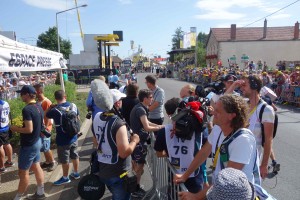
TV crews and photographers await the arrival of the peloton in the Mixed Zone beyond the finish line
“Last year we had an OB truck, a tender, a large edit truck and an uplink truck,” said Burns. “Outside Broadcast had done it in the past, before they became part of the NEP Group. Then with scheduling issues and resources being available, to get down to Rio, a lot of the Belgian trucks were fixed on the Opening Ceremony in Rio. So that’s where NEP UK and Ireland became involved, supporting our Belgian colleagues. Last year it was a bigger set-up; it has slightly shrunk this year. Then we had a huge edit truck but now we’ve put the edit facilities into the big uplink truck, just to try to minimise with one less vehicle.
“Up until last year the uplinking had been done by Arqiva,” said Burns. “They left the SNG market, so we went in and said OK we’ll do that as well. We brought one of the big ones, the Megalinks with the big dishes last year, rather than a Sprinter-type vehicle. With the big rainstorm we had in the Pyrenees, it enabled us to guarantee the pictures out. Then we said, well what else can we put in it to supplement the footprint in the compound? So last year we put the graphics timing guys in it and this year we’ve put a load of Avid editing in there,” he said.
“On the up-and-out studio truck we’re using a Rosco polariser system on the front of the lenses so we can adjust the neutral density of the background panels. There’s a filter on the front of the camera, and on the glass behind the presenters, and when you turn it against the polariser it darkens the background. This allows for really bright days like today.
“When you close up the truck at night, all the kit goes in the middle of the floor so everything doesn’t
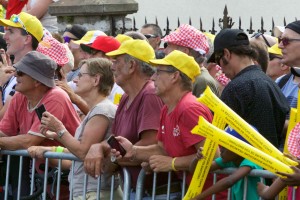
Cycling fans near the finish line for Stage 7 at Nuits-Saint-George, Friday 7 July. Photo: Tom Woods
have to be de-rigged,” said Burns. “You have to be inside these two hinges and they stack everything up. They drive from where they were last night: some of the guys sleep in their caravans, some in hotels and some in the trucks. The big thing each morning at 5 or 6am is to get a position with a view for the studio truck. If we don’t have a view it becomes even more important, to make sure we’re not looking at someone else’s truck or with someone else’s brand in view.
“They open up this truck at about 6.30 am: that takes about 45 minutes which is amazingly short. And it takes about the same time to close it up in the evening. Today they had to put cables easily 300 metres to the finish line. The guys that are on the ground laying cables are amazing. They’re first in and last out every day,” said Burns.
